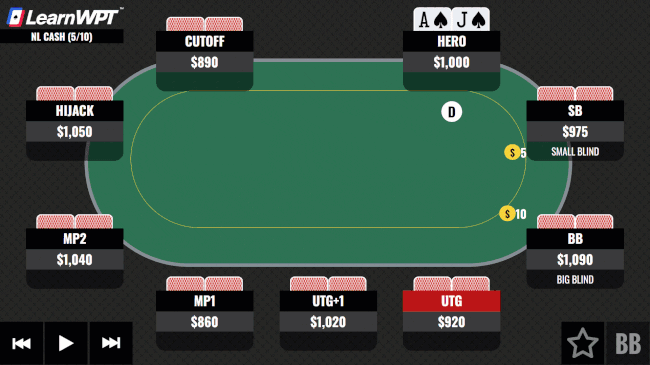Poker Quiz! Facing a C-Bet With A♠J♠ in a 3-Bet Pot...
DECISION POINT: You are about 20 minutes into a live $5/$10 cash game session where most of the stacks are around 100 big blinds and you have $1,000. Action folds to you on the Button and you make the table standard raise to $30 with A♠J♠. The Small Blind folds, the Big Blind 3-bets to $120, you call. Your opponent bets $120 on the A♥7♠2♠ flop and action is on you.
What do you do here?
PRO ANSWER: We’ve just recently joined a 9-handed $5/$10 cash game. Most stacks are around 100 big blinds and we start the hand with $1,000 and A♠J♠ on the Button. Action folds around to us, and with AsJs we have a hand that is certainly strong enough to open with first-in to the pot from the Button, so we make the standard table raise to $30. The Small Blind folds and the Big Blind 3-bets to $120.
When the Big Blind 3-bets us, they are representing a very polarized range. This is especially true as the Big Blind is in a favorable spot to call with many hands as they are getting a great price to call and are guaranteed to see a flop as the last player to close the action preflop. Our specific hand AJs is strong enough to continue with, however not strong enough that we want to 4-bet.
We call and the flop comes A♥7♠2♠. This is about the best flop we can see when we make only 1-pair in this scenario. If the Ah were the Jh we might feel slightly more confident in this spot since our opponent’s 3-betting range has many more Ax hands than Jx, however we are still pretty happy with this Ace high flop with 2 low cards.
Our opponent comes out firing, making it $120.
Continued Below ...
The first step in deciding our best approach to this c-bet is to consider the Big Blind’s likely range. We can assume they 3-bet preflop with a range including a lot of big Ax hands, some bigger pocket pairs, plus some smaller portion of suited connectors and other hands to balance out their preflop polar range. This is a very tempting spot to raise, and doing so certainly is +EV.
However if we take a closer look at the Big Blind’s range we can assume if we raise they are likely to only continue with the Ax hands that have us outkicked, or hands such as 77/A7s. We have very little reason to protect ourselves against their TT-KK type holdings, and if they have complete air we would welcome them to continue bluffing on future streets. Continuing by calling allows us to keep weaker hands in the Big Blind’s range that might continue to bluff, and gives us a great price to draw the times we are behind.
While we might be faced with some trickier turn and river decisions when we call and don’t improve, calling will maximize our expected value against their entire range.
Calling is the best play.
How would you play it?
Share your answer in the comments below!
Improve Your Game Today!
Join LearnWPT and Get:
- The WPT GTO Trainer to play real solved hands and get instant feedback on YOUR leaks (over 4 BILLION solved spots!)
- On-demand access to our full library of 500+ (and growing) in-depth Strategy Episodes from world-class players
- All of your poker questions answered with the Ask a Pro Feature
- Expert analysis from LearnWPT Pros using The Hand Input Tool
- Downloadable Tools you can use at and away from the tables
- Learn from a Team of world-class Professional Players
To join (just $5 your 1st month) click the JOIN NOW button and start improving your game!
Have Questions about LearnWPT? Email us at [email protected].

